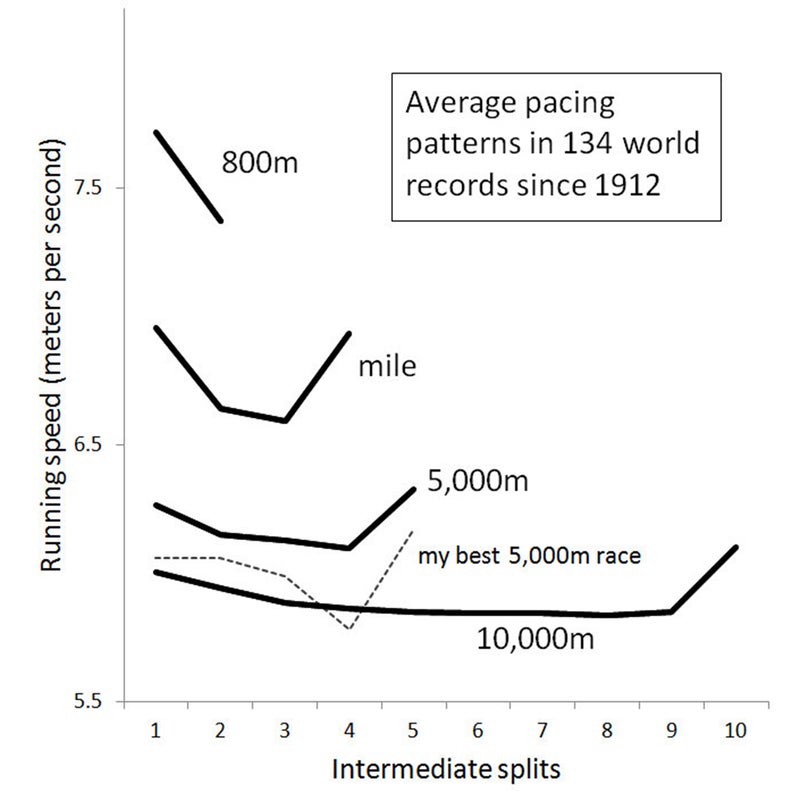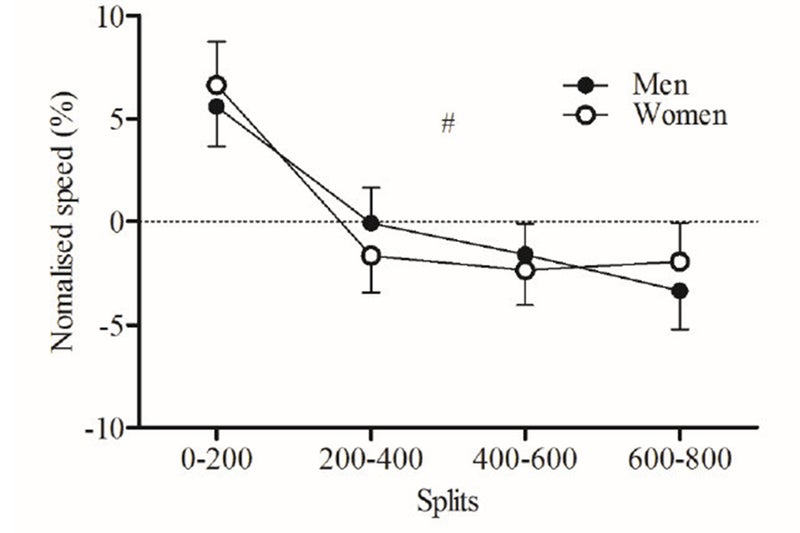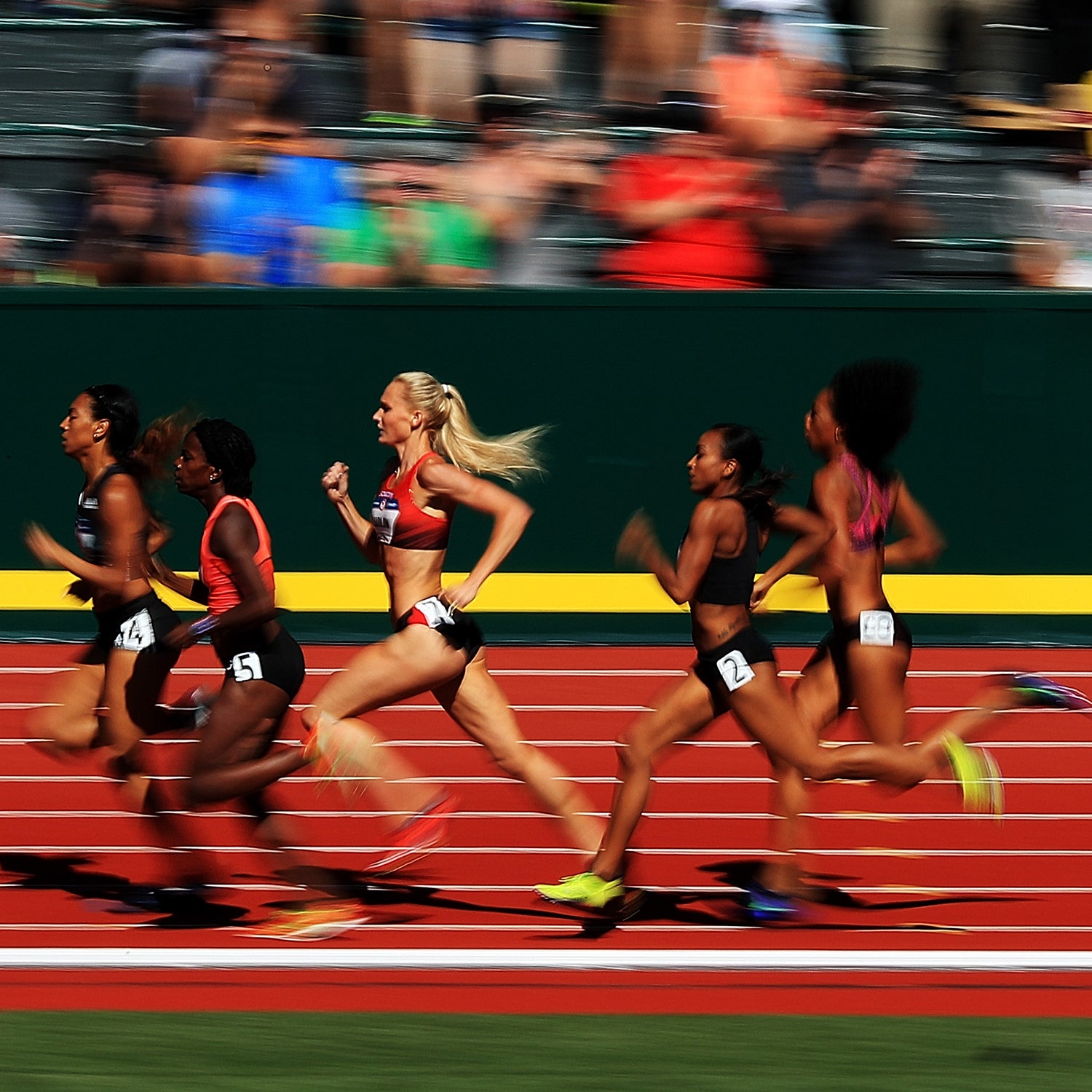For many years, I assumed that Aesop was the ultimate authority on pacing: slow and steady, like the tortoise, wins the race. But for all the seductive simplicity of even pacing, very few world records are actually set that way. In fact, as I noted when I wrote about optimal marathon pacing a few months ago, even the best runners, coaches, and researchers in the world still have varying opinions on the best approach.��That’s why it’s instructive to look at what actually happens in real life when top runners are having a good day.
��
To that end, in the International Journal of Sports Physiology and Performance takes an in-depth look at the pacing patterns of the world’s best 800-meter runners in recent years. Researchers from Italy looked at the 20 fastest male and female performers each year between 2010 and 2016, dug up their season’s-best races on YouTube, and analyzed each performance to calculate the intermediate times after 200, 400, and 600 meters. Of the potential data set of 280 races (seven years, top 20 for men and women), they were able to find data for 142 of them, which is pretty impressive. The big advantage of this paper, compared to a lot of the previous research in this area, is the ability to directly compare the pacing patterns of men and women to see if there are any consistent differences.
��
The 800, which takes just under two minutes for top runners, is a particularly interesting distance to consider, because it lies right at��the border between sprint and endurance events. The pacing in sprints is generally pretty straightforward: you start really fast, and hang on as best you can, slowing gradually all the way to the finish. In endurance events, by contrast, you tend to see a U-shaped pattern: you start fast, then settle into a sustainable and relatively even pace, then you pick it up at the end.
��
In a discussion of this topic in my book, , I included this figure, based on of a century’s worth of men’s world records by Ross Tucker, Mike Lambert, and Tim Noakes:

You can see the finishing sprint, where the curves bend upward, in the longer races, but it’s absent in the 800. Exactly why this occurs is a long discussion (a whole chapter of the book!), but it has to do with the balance between fatigue in the central nervous system and fatigue in the muscles themselves. toward the end of an 800, sending increasingly powerful signals to the muscles—but your muscles can no longer respond.
��
Two things are missing from this graph, though: women’s records, and a sense of how pacing patterns might be changing with new generations of athletes. So here’s what the new study, led by Luca Filipas of the Università degli Studi di Milano, found:

Shown here are the average speeds for the four sections of the race, as a percentage of the final time. The men start very fast, then get progressively slower with each succeeding split. The women also start very fast, but then settle into an even pace for the remainder of the race (with, perhaps, the slight hint of a finishing kick).
��
Why should men and women have different pacing patterns? One simple explanation is that the men are running a race that takes (in this data set) 1:43.5 on average; the women are running a race than take 1:58.2 on average. Given that the 800 seems to be right on the border between sprint and endurance, it’s plausible that this difference in duration allows the men to run it more like a sprint, while the women’s pacing looks a little closer to the patterns seen in longer races.
��
There are some more subtle, and perhaps controversial, possibilities. Robert Deaner, a psychologist at Grand Valley State University, has done a lot of research on in longer races, and has consistently found that women pace themselves more evenly while men are more likely to start fast and then fade. He attributes this to differences in competitive behavior reflecting, at least in part, “innate predispositions that evolved in response to the difference challenges men and women faced during our evolutionary history.”
��
Deaner’s views are speculative, and others have suggested various alternate explanations for the findings, including differences in participation that may reflect social barriers and opportunities. While the 800-meter data seems to fit this pattern, since the women run more evenly, the story doesn’t quite fit: the women actually have a slightly more aggressive start than the men in the first 200 meters.
��
Instead, the authors of the new study suggest, there may be more subtle tactical factors at work. The 800 is the shortest race where everyone has to jockey for position on the track (the 400 meters is run entirely in lanes), so positioning at the cut-in point, roughly 100 meters into the race, is crucial. Physiology aside, there’s a big game theoretic advantage to starting fast to avoid getting stuck behind your competitors. By several measures, the top men’s 800 runners are more evenly matched than the top women’s 800 runners (e.g. there’s a 2.33 percent gap from 1st to 8th place in men’s Diamond League races, on average, compared to a 2.95 percent gap for women’s races). So, in this theory, both men and women start hard to ensure good positioning at the cut-in, but the women can ease up a bit in the second 200 because there’s less jockeying for position.
��
One final point worth noting is the changing nature of the event. It’s a bit of a cliché to say that modern 800 runners are so fast that the event has transitioned from a middle-distance event to a long sprint. But there’s some evidence that this is happening. Ross Tucker that improvements in men’s 800 times in recent decades have come mostly from blasting the first lap more quickly. A few months ago, I met a researcher from New Zealand named who’s been traveling the world testing the top speed of world class 800-meter runners, exploring the role of what he calls “.” To handle the blazing first lap of a world-class 800 these days, he argues, you increasingly need to have world-class top-end sprint speed.
��
The authors of the new Italian paper make a similar point by looking at a couple of semi-arbitrary thresholds for world-class sprint speed. In 2000, of the top 20 800-meter runners in the world, none of the men had ever run sub-46 for 400 meters, and nine of the women had run sub-53. By 2012, there were five sub-46 runners among the top 20 men, but still just nine sub-53 runners among the top women. There’s evidence, in other words, that the 800 is becoming more of a sprinter’s game for the men, but not yet for the women—perhaps because the race is 14 percent longer (in time, not distance) for the women, so still requires that little extra bit of endurance.
��
If you’re an 800-meter runner, you might want to plot the splits from some of your best races to see how your pattern compares. You shouldn’t necessarily try to match the average split pattern shown here, but seeing where you diverge might offer some insights about your strengths and weaknesses that will inform your tactical decisions.
��
For the rest of us, I think the takeaway is broader: pacing isn’t as simple as we often assume. It depends on psychology as much as physiology, and on the actions of the competitors around you as much as on your own pre-race plan. The best advice I can offer is that you shouldn’t assume that whatever you’re doing now is the best possible pacing plan. Experiment; try going out hard; try holding back. You might fail, but you won’t know until you give it a shot.
My new book, , with a foreword by Malcolm Gladwell, is now available. For more, join me on and , and sign up for the Sweat Science .


